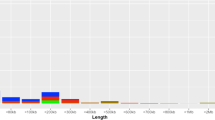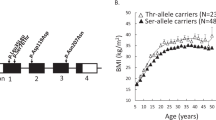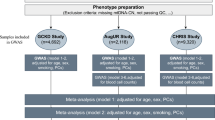Abstract
OBJECTIVE:
Genomic copy number variations (CNVs) have been strongly implicated as important genetic factors for obesity. A recent genome-wide association study identified a novel variant, rs12444979, which is in high linkage disequilibrium with CNV 16p12.3, for association with obesity in Europeans. The aim of this study was to directly examine the relationship between the CNV 16p12.3 and obesity phenotypes, including body mass index (BMI) and body fat mass.
SUBJECTS:
Subjects were a multi-ethnic sample, including 2286 unrelated subjects from a European population and 1627 unrelated Han subjects from a Chinese population. Body fat mass was measured using dual energy X-ray absorptiometry.
RESULTS:
Using Affymetrix Genome-Wide Human SNP Array 6.0, we directly detected CNV 16p12.3, with the deletion frequency of 27.26 and 0.8% in the European and Chinese populations, respectively. We confirmed the significant association between this CNV and obesity (BMI: P=1.38 × 10−2; body fat mass: P=2.13 × 10−3) in the European population. Less copy numbers were associated with lower BMI and body fat mass, and the effect size was estimated to be 0.62 (BMI) and 1.41 (body fat mass), respectively. However, for the Chinese population, we did not observe significant association signal, and the frequencies of this deletion CNV are quite different between the European and Chinese populations (P<0.001).
CONCLUSION:
Our findings first suggest that CNV 16p12.3 might be ethnic specific and cause ethnic phenotypic diversity, which may provide some new clues into the understanding of the genetic architecture of obesity.
This is a preview of subscription content, access via your institution
Access options
Subscribe to this journal
Receive 12 print issues and online access
$259.00 per year
only $21.58 per issue
Buy this article
- Purchase on Springer Link
- Instant access to full article PDF
Prices may be subject to local taxes which are calculated during checkout

Similar content being viewed by others
References
Kopelman PG . Obesity as a medical problem. Nature 2000; 404: 635–643.
Lewis CE, McTigue KM, Burke LE, Poirier P, Eckel RH, Howard BV et al. Mortality, health outcomes, and body mass index in the overweight range: a science advisory from the American Heart Association. Circulation 2009; 119: 3263–3271.
Maes HH, Neale MC, Eaves LJ . Genetic and environmental factors in relative body weight and human adiposity. Behav Genet 1997; 27: 325–351.
Stunkard AJ, Foch TT, Hrubec Z . A twin study of human obesity. JAMA 1986; 256: 51–54.
Chambers JC, Elliott P, Zabaneh D, Zhang W, Li Y, Froguel P et al. Common genetic variation near MC4R is associated with waist circumference and insulin resistance. Nat Genet 2008; 40: 716–718.
Dina C, Meyre D, Gallina S, Durand E, Korner A, Jacobson P et al. Variation in FTO contributes to childhood obesity and severe adult obesity. Nat Genet 2007; 39: 724–726.
Frayling TM, Timpson NJ, Weedon MN, Zeggini E, Freathy RM, Lindgren CM et al. A common variant in the FTO gene is associated with body mass index and predisposes to childhood and adult obesity. Science 2007; 316: 889–894.
Loos RJ, Lindgren CM, Li S, Wheeler E, Zhao JH, Prokopenko I et al. Common variants near MC4R are associated with fat mass, weight and risk of obesity. Nat Genet 2008; 40: 768–775.
Walley AJ, Asher JE, Froguel P . The genetic contribution to non-syndromic human obesity. Nat Rev Genet 2009; 10: 431–442.
Sebat J, Lakshmi B, Malhotra D, Troge J, Lese-Martin C, Walsh T et al. Strong association of de novo copy number mutations with autism. Science 2007; 316: 445–449.
Stefansson H, Rujescu D, Cichon S, Pietilainen OP, Ingason A, Steinberg S et al. Large recurrent microdeletions associated with schizophrenia. Nature 2008; 455: 232–236.
Yang TL, Chen XD, Guo Y, Lei SF, Wang JT, Zhou Q et al. Genome-wide copy-number-variation study identified a susceptibility gene, UGT2B17, for osteoporosis. Am J Hum Genet 2008; 83: 663–674.
Bochukova EG, Huang N, Keogh J, Henning E, Purmann C, Blaszczyk K et al. Large, rare chromosomal deletions associated with severe early-onset obesity. Nature 2010; 463: 666–670.
Walters RG, Jacquemont S, Valsesia A, de Smith AJ, Martinet D, Andersson J et al. A new highly penetrant form of obesity due to deletions on chromosome 16p11.2. Nature 2010; 463: 671–675.
Sha BY, Yang TL, Zhao LJ, Chen XD, Guo Y, Chen Y et al. Genome-wide association study suggested copy number variation may be associated with body mass index in the Chinese population. J Hum Genet 2009; 54: 199–202.
Jarick I, Vogel CI, Scherag S, Schafer H, Hebebrand J, Hinney A et al. Novel common copy number variation for early onset extreme obesity on chromosome 11q11 identified by a genome-wide analysis. Hum Mol Genet 2011; 20: 840–852.
Willer CJ, Speliotes EK, Loos RJ, Li S, Lindgren CM, Heid IM et al. Six new loci associated with body mass index highlight a neuronal influence on body weight regulation. Nat Genet 2009; 41: 25–34.
Speliotes EK, Willer CJ, Berndt SI, Monda KL, Thorleifsson G, Jackson AU et al. Association analyses of 249,796 individuals reveal 18 new loci associated with body mass index. Nat Genet 2010; 42: 937–948.
Deng HW, Deng H, Liu YJ, Liu YZ, Xu FH, Shen H et al. A genomewide linkage scan for quantitative-trait loci for obesity phenotypes. Am J Hum Genet 2002; 70: 1138–1151.
Yang TL, Guo Y, Liu YJ, Shen H, Liu YZ, Lei SF et al. Genetic variants in the SOX6 gene are associated with bone mineral density in both Caucasian and Chinese populations. Osteoporos Int 2012; 23: 781–787.
Korn JM, Kuruvilla FG, McCarroll SA, Wysoker A, Nemesh J, Cawley S et al. Integrated genotype calling and association analysis of SNPs, common copy number polymorphisms and rare CNVs. Nat Genet 2008; 40: 1253–1260.
McCarroll SA, Kuruvilla FG, Korn JM, Cawley S, Nemesh J, Wysoker A et al. Integrated detection and population-genetic analysis of SNPs and copy number variation. Nat Genet 2008; 40: 1166–1174.
Price AL, Patterson NJ, Plenge RM, Weinblatt ME, Shadick NA, Reich D . Principal components analysis corrects for stratification in genome-wide association studies. Nat Genet 2006; 38: 904–909.
Acknowledgements
This work was supported by the National Natural Science Foundation of China (81000363, 31000554), the Grants from NIH (R01 AR050496, R21 AG027110, R01 AG026564, P50 AR055081, R01 AR057049-01A1 and R21 AA015973). The study was also funded by the Fundamental Research Funds for the Central Universities, the PhD Programs Foundation of Ministry of Education of China (20100201120058), Shanghai Leading Academic Discipline Project (S30501), a Grant from Ministry of Education to ShangHai University of Science and Technology, and startup fund from University of Shanghai for Science and Technology, Xi’an Jiaotong University and the Ministry of Education of China. This work was also supported by Dr Hong-Wen Deng’s Dickson/Missouri Endowment at University of Missouri-Kansas City and the Edward G Schlieder Endowment at Tulane University.
Author information
Authors and Affiliations
Corresponding author
Ethics declarations
Competing interests
The authors declare no conflict of interest.
Rights and permissions
About this article
Cite this article
Yang, TL., Guo, Y., Li, S. et al. Ethnic differentiation of copy number variation on chromosome 16p12.3 for association with obesity phenotypes in European and Chinese populations. Int J Obes 37, 188–190 (2013). https://doi.org/10.1038/ijo.2012.31
Received:
Revised:
Accepted:
Published:
Issue Date:
DOI: https://doi.org/10.1038/ijo.2012.31
Keywords
This article is cited by
-
Association between copy-number variation on metabolic phenotypes and HDL-C levels in patients with polycystic ovary syndrome
Molecular Biology Reports (2017)
-
Exome sequencing followed by genotyping suggests SYPL2 as a susceptibility gene for morbid obesity
European Journal of Human Genetics (2015)
-
Obesity and genomics: role of technology in unraveling the complex genetic architecture of obesity
Human Genetics (2015)
-
Etiology of Obesity Over the Life Span: Ecological and Genetic Highlights from Asian Countries
Current Obesity Reports (2014)



